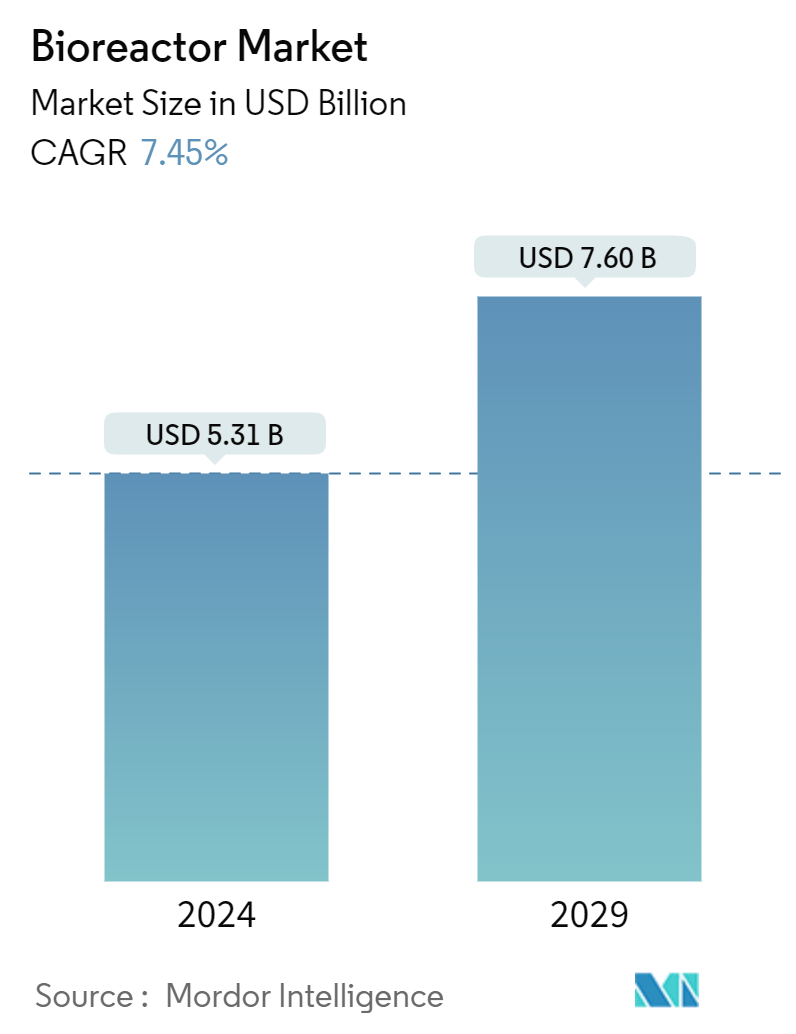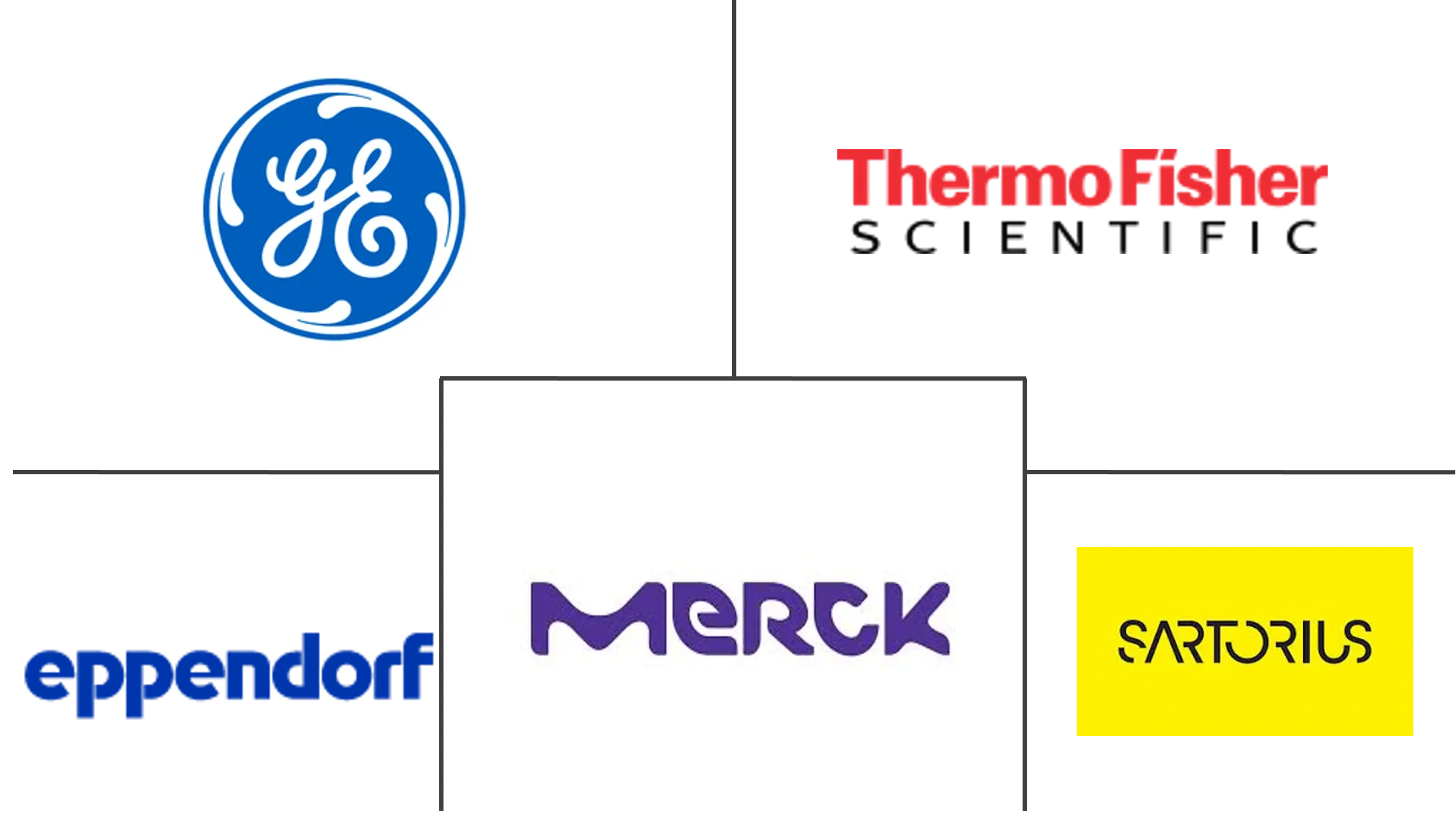Market Size of Bioreactor Industry

| Study Period | 2021 - 2029 |
| Market Size (2024) | USD 5.31 Billion |
| Market Size (2029) | USD 7.60 Billion |
| CAGR (2024 - 2029) | 7.45 % |
| Fastest Growing Market | Asia Pacific |
| Largest Market | North America |
Major Players
*Disclaimer: Major Players sorted in no particular order |
Bioreactors Market Analysis
The Bioreactor Market size is estimated at USD 5.31 billion in 2024, and is expected to reach USD 7.60 billion by 2029, growing at a CAGR of 7.45% during the forecast period (2024-2029).
Bioreactors in the pharmaceutical industry have great potential uses in the development of vaccines and other pharmaceutical products that are being used to mitigate the spread of COVID-19 across the world. The high demand from governmental vaccination programs and private entities to vaccinate large sections of the population requires scientists to work under pressure to shorten the time-to-market of developed vaccines. This has created a huge demand in the Bioreactor industry from the biopharmaceutical and biotechnology sectors during the early phase of the pandemic. According to an article published by Frontiers in August 2022, Cell culture bioreactors were widely used in viral vaccine production during the COVID-19 pandemic, and the development and application of bioreactors provided more efficient and cost-effective vaccine production to meet the global vaccine demand. Thus, COVID-19 had a positive impact on the Global bioreactors market initially. However, currently, the market growth slowed down as the pandemic subsided, and it is expected to witness stable growth during the forecast period of the study.
Factors such as the growth of bioreactors in pharmaceuticals, technological advancements, and adoption of single-use bioreactors (SUBs) and hybrid bioreactors are the prime drivers of the Bioreactors market currently.
Biopharmaceuticals are utilized in a range of applications, from being in the production of biopharmaceuticals to applications in tissue engineering, such as cell expansion and generation of 3D tissue constructs. Bioreactors in the pharmaceutical industry are used to provide a controllable environment, in terms of pH, temperature, nutrient supply, and shear stress for any cells or cellular constructs incorporated into them. For instance, according to an article published by PubMed Central in February 2022, bioreactors allow production to be increased to industrial scales, which can quickly and cheaply produce large amounts of secondary metabolites and recombinant proteins in a short time. Bioreactors have been utilized in many different areas of industry and research, including Microbial fermentation and the progression of in vitro models of 2D cultures and suspensions to 3D constructs, mimicking the natural physiological state in situ. They have also proven to be crucial medicines that are used in autoimmune disorders, cancer, asthma, and organ rejection. Thus, the growth of bioreactors, including those in the Medical bioreactor market, is a major factor augmenting the growth of the market.
Furthermore, technological advancements in bioreactors and fermenters have improved the flexibility, quality, and scalability of operations with low capital and energy requirements. These innovations in Upstream bioprocessing methods and analytical tools are projected to enhance process robustness, accelerate scale-up to industrial production, and drive the efficient use of resources. The extensive use of hybrid bioreactor technology in effective waste management has also further accelerated the expansion of the market.
Initiatives by major Bioreactor manufacturers are also boosting the market growth. For instance, in May 2021, Beckman Coulter Life Sciences launched its next-generation Biolector XT Microbioreactor in Germany. The BioLector XT Microbioreactor allows cultivation parameter monitoring, high-throughput strain screenings, and feeding strategy optimization.
Thus, owing to the benefits offered by bioreactor technology and its increasing applications, the Bioreactors market is expected to witness significant growth over the forecast period. However, concerns regarding the use of single-use bioreactors and limited storage capacity can hamper the market growth.
Bioreactors Industry Segmentation
As per the scope of the report, bioreactors are large vessels used in industries that provide optimum conditions for the growth of microorganisms to carry out the biochemical process. They are used to speed up biochemical processes, such as fermentation and antibiotic drug production, where bacteria or yeast are added as inoculum to carry out the reaction. The bioreactor market is segmented by type (glass, stainless steel, and single-use), usage (lab-scale production, pilot-scale production, and full-scale production), scale (5L-20L, 20L-200L, 200L-1,500L, and above 1,500L), control (manual and automated), and geography (North America, Europe, Asia-Pacific, Middle East and Africa, and South America). The report offers the value (in USD million) for the above segments. The market report also covers the estimated market sizes and trends for 17 different countries across major regions globally.
| By Type | |
| Glass | |
| Stainless Steel | |
| Single-use |
| By Usage | |
| Lab-scale Production | |
| Pilot-scale Production | |
| Full-scale Production |
| By Scale | |
| 5L-20L | |
| 20L-200L | |
| 200L-1,500L | |
| Above 1,500L |
| By Control Type | |
| Manual | |
| Automated (MFCs) |
| By Geography | ||||||||
| ||||||||
| ||||||||
| ||||||||
| ||||||||
|
Bioreactor Market Size Summary
The bioreactor market is poised for significant growth, driven by its critical role in the biopharmaceutical and biotechnology sectors. Initially spurred by the COVID-19 pandemic, which heightened the demand for efficient vaccine production, the market has since stabilized and is expected to experience steady expansion. The increasing application of bioreactors in pharmaceuticals, particularly in vaccine development and tissue engineering, underscores their importance. Technological advancements, such as the adoption of single-use and hybrid bioreactors, have further enhanced their flexibility, scalability, and cost-effectiveness. These innovations are crucial for meeting the growing demand for biopharmaceuticals and for optimizing production processes across various industries.
North America currently dominates the bioreactor market, with the United States leading due to substantial investments in biotechnology research and development. The region's stronghold is expected to continue, supported by collaborations between industry and academic institutions. The market is characterized by moderate fragmentation, with major players like Sartorius AG, Thermo Fisher Scientific Inc., and Pall Corporation holding significant shares. However, technological advancements and competitive pricing strategies are enabling mid-size and smaller companies to expand their market presence. The ongoing demand for biopharmaceutical products and the focus on localized production are anticipated to further drive market growth in the coming years.
Bioreactor Market Size - Table of Contents
-
1. MARKET DYNAMICS
-
1.1 Market Overview
-
1.2 Market Drivers
-
1.2.1 Growth of Bioreactors in Pharmaceuticals
-
1.2.2 Technological Advancements in Bioreactors
-
1.2.3 Adoption of Single-use bioreactors (SUBs) and Hybrid Bioreactors
-
-
1.3 Market Restraints
-
1.3.1 Concerns Regarding the Use of Single-use Bioreactors (SUBs)
-
1.3.2 Limited Storage Capacity
-
-
1.4 Industry Attractiveness - Porter's Five Forces Analysis
-
1.4.1 Threat of New Entrants
-
1.4.2 Bargaining Power of Buyers/Consumers
-
1.4.3 Bargaining Power of Suppliers
-
1.4.4 Threat of Substitute Products
-
1.4.5 Intensity of Competitive Rivalry
-
-
-
2. MARKET SEGMENTATION
-
2.1 By Type
-
2.1.1 Glass
-
2.1.2 Stainless Steel
-
2.1.3 Single-use
-
-
2.2 By Usage
-
2.2.1 Lab-scale Production
-
2.2.2 Pilot-scale Production
-
2.2.3 Full-scale Production
-
-
2.3 By Scale
-
2.3.1 5L-20L
-
2.3.2 20L-200L
-
2.3.3 200L-1,500L
-
2.3.4 Above 1,500L
-
-
2.4 By Control Type
-
2.4.1 Manual
-
2.4.2 Automated (MFCs)
-
-
2.5 By Geography
-
2.5.1 North America
-
2.5.1.1 United States
-
2.5.1.2 Canada
-
2.5.1.3 Mexico
-
-
2.5.2 Europe
-
2.5.2.1 Germany
-
2.5.2.2 United Kingdom
-
2.5.2.3 France
-
2.5.2.4 Italy
-
2.5.2.5 Spain
-
2.5.2.6 Rest of Europe
-
-
2.5.3 Asia-Pacific
-
2.5.3.1 China
-
2.5.3.2 Japan
-
2.5.3.3 India
-
2.5.3.4 Australia
-
2.5.3.5 South Korea
-
2.5.3.6 Rest of Asia-Pacific
-
-
2.5.4 Middle East and Africa
-
2.5.4.1 GCC
-
2.5.4.2 South Africa
-
2.5.4.3 Rest of Middle East and Africa
-
-
2.5.5 South America
-
2.5.5.1 Brazil
-
2.5.5.2 Argentina
-
2.5.5.3 Rest of South America
-
-
-
Bioreactor Market Size FAQs
How big is the Bioreactor Market?
The Bioreactor Market size is expected to reach USD 5.31 billion in 2024 and grow at a CAGR of 7.45% to reach USD 7.60 billion by 2029.
What is the current Bioreactor Market size?
In 2024, the Bioreactor Market size is expected to reach USD 5.31 billion.

